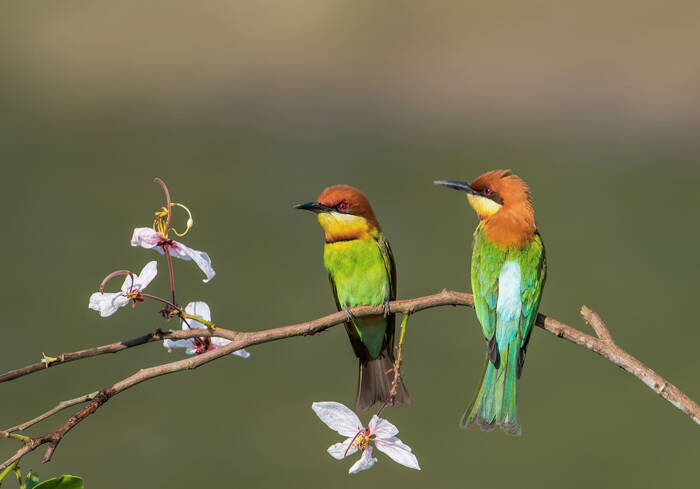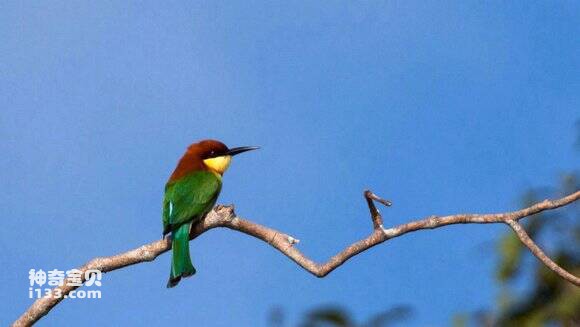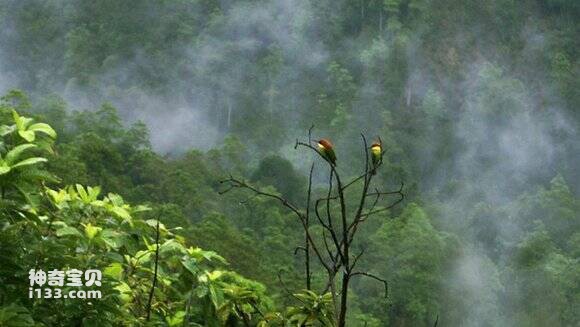Merops leschenaulti
IUCN
LCBasic Information
Scientific classification
- name:Merops leschenaulti
- Scientific Name:Black-breasted Bee-eater,Merops leschenaulti,Chestnut-headed Bee-eater
- Outline:Climbing birds
- Family:order family genus
Vital signs
- length:20-21cm
- Weight:25-26g
- lifetime:No verification information
Feature
The feathers are mainly green and brown, with bright chestnut on the head, nape and upper back.
Distribution and Habitat
Distributed in Bangladesh, Bhutan, Cambodia, China, India, Indonesia, Lao People's Democratic Republic, Malaysia, Myanmar, Nepal, Sri Lanka, Thailand, Vietnam.
Lives in forest areas. Mainly inhabits open places such as forest edges, sparse grass slopes, foothills and open plains with tree-growing cliffs, steep slopes and river valleys. Sometimes it appears in plain jungles, shrubs, and even reed swamps in winter. Active in open areas such as foothills, cultivated land, and around lakes.
Appearance
The chestnut-headed bee-eater has a wide stripe above the eyes, crossing the chestnut ear feathers and a narrow forehead stripe that is black; the rest of the head to the upper back is brown and chestnut; the surface of the lower back and wings are grass green, and the ends of the innermost flight feathers are stained blue, and the primary flight feathers are blue. The periphery of the first feather, the ends and inner edges of the remaining flight feathers are all dark brown, the base of the inner feathers and the axillary feathers are reddish brown, and a large wing spot can be seen when the wings are spread; the waist and upper tail coverts are light blue; the tail feathers are dark grass green, The outer quills of the central pair are stained blue, and the inner quills and feather tips of the outer pairs have black feather edges. The chin and throat are light yellow, with a brown and chestnut band under the throat, which blends with the same color as the back. There is a black ring
Details
Chestnut-headed Bee-eater, also known as Chestnut-headed Bee-eater, has 3 subspecies.

The chestnut-headed bee-eater migrates to southeastern China in summer, living in hills or woodlands. It mostly flies and hunts in the air, accompanied by a trilling call, and sometimes stands on the top branches of trees.
Chestnut-headed bee-eaters like to live in groups, which are composed of more than 10 to nearly 100 individuals. However, they do not mix with other birds, but live alone in groups, and sometimes the larger groups are as many as hundreds of individuals. They are lively and active. When they live together, they always make a lot of noise, and their voices can be heard far away. They are good at swimming and diving, and they fly very fast. When they fly from the water, they always chirp constantly. At night, they usually live on the water surface, in shallow water near the water, or on the beach. Every day at dawn, they fly to the grassland in groups to find food, and return to the waterside to rest, drink water and swallow sand at noon. Sometimes they also live in the foraging area at night. When the weather is bad, especially when there is a storm, they often hide in the reeds. When flying, the formation of the group is very irregular, sometimes flying in a diagonal line, which is very irregular. Whenever they are about to land on the water, they always circle in groups above the water for a few rounds, then turn their direction almost at the same time, falling to the water like arrows, and then gather into a dense group on the water.

The chestnut-headed bee-eater mainly feeds on various insects. It likes to eat bees. Its food varies depending on the location and season. In addition to bees, it also preys on insects such as weevils, elm moths, horseflies, dragonflies, termites, butterflies, and other lepidopterans, as well as crustaceans. It often lives on branches or electric wires and waits quietly. Once a flying insect approaches, it flies to it and eats it. It also preys in the air, preying while flying.

The breeding season of the chestnut-headed bee-eater is from May to July. They often breed in groups, ranging from a few pairs to nearly a hundred pairs, and rarely breed alone in pairs. They usually nest on steep river banks, cliffs and valleys. The nest is tunnel-shaped. The male and female parent birds take turns digging holes for the nest. The nest is tunnel-shaped. They dig with their mouths and dig out the soil with their feet. The diameter and length vary with the soil. In places where it is easy to dig, the tunnel is sometimes as long as 1-2 meters. In places with harder soil, the length of the tunnel is only 15-20 cm. The hole is 5-8 cm in diameter. The end of the nest hole is expanded to form a nesting chamber for laying eggs. The diameter is mostly 15-20 cm and the height is 12-15 cm. It takes about 10-20 days to dig each nest hole. There is no inner cushion in the nest chamber, and the eggs are laid directly on the ground in the nest chamber. One nest is reproduced per year, and each nest lays 5-6 eggs. The eggs are white and oval. The size is 24-29 mm × 20-23 mm. The male and female birds take turns to incubate, with the female bird taking the lead. The incubation period is about 20 days. The chicks are late-maturing, and the male and female parent birds raise them together.
Listed in the IUCN Red List of Threatened Species in 2016 ver 3.1-Least Concern (LC).
Listed in China's National List of Key Protected Wildlife (February 5, 2021) Level 2.
Protect wildlife and eliminate game.
Maintaining ecological balance is everyone's responsibility!








